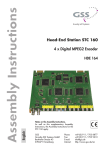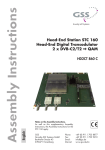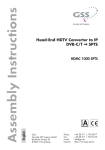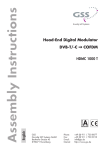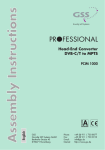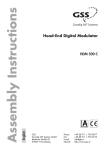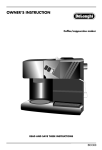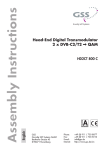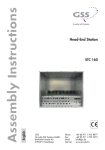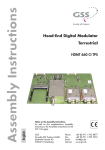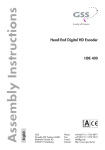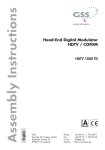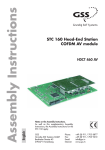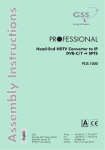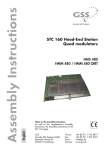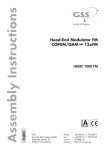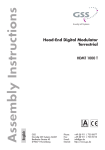Download Kopfstation STC 160 Head-End Digital Transmodulator 4 x
Transcript
Kopfstation STC 160 Head-End Digital Transmodulator 4 x DVB-C/T QAM HDMC 764 C English Notes on the Assembly Instructions. As well as this supplementary Assembly Instructions, the Assembly Instructions for the STC 160 apply. GSS Grundig SAT Systems GmbH Beuthener Strasse 43 D-90471 Nuremberg Phone: Fax: Email: Internet: +49 (0) 911 / 703 8877 +49 (0) 911 / 703 9210 [email protected] www.gss.de/en.html Contents 1 Safety regulations........................................................................................ 3 2 General information..................................................................................... 4 2.1 Scope of delivery...........................................................................4 2.2 Meaning of the symbols used...........................................................4 2.3 Technical data................................................................................5 2.4 Description....................................................................................6 How the TPS module works..............................................................7 Station filter..............................................................................7 Changing the Transport stream and ORGNET-ID...........................7 Changing the NIT......................................................................7 3 Installation................................................................................................... 7 3.1 Retrofitting a CA module.................................................................8 3.2 Installing the QAM module..............................................................9 3.3 Connecting the QAM module........................................................10 4 The control panel at a glance...................................................................... 11 4.1 Functions of the control panel buttons..............................................11 4.2 Menu items..................................................................................11 5 Programming............................................................................................. 12 5.1 Preparation..................................................................................12 5.2 Programming procedure................................................................13 5.3 Programming the QAM module......................................................16 Selecting the module / channel strip...............................................16 Output settings.............................................................................17 Modulator on/off, Level...........................................................18 Channel / Frequency...............................................................18 Output symbol rate, QAM modulation ........................................ 20 Substitute signal in the case of an incorrect input signal................21 Input settings................................................................................22 Kind of modulation / Symbol rate.............................................22 Input channel / frequency........................................................23 Operation with a CA module....................................................24 Station filter............................................................................24 PID monitoring........................................................................25 CA module.............................................................................26 Options settings............................................................................27 Transport stream ID and ORGNET-ID..........................................28 BAT/SDT-OTHER tables............................................................28 Deleting a PID.........................................................................29 Renaming a PID......................................................................29 - 2 - HDMC 764 C Output data rate...........................................................................30 Network Information Table (NIT).....................................................31 Factory reset................................................................................32 Saving data.................................................................................33 6 Final procedures......................................................................................... 34 7 Channel and frequency tables..................................................................... 35 1S a f e t y regulations • The standards EN/DIN EN 50083 resp. IEC/EN/DIN EN 60728 must be observed. • Do not perform installation and service work during thunderstorms. • Assembly, installation and servicing should be carried out by authorised electricians. • Switch off the operating voltage of the system before beginning with assembly or service work. • Avoid short circuits! • Observe the relevant standards, regulations and guidelines on the installation and operation of antenna systems. • To ensure electromagnetic compatibility, make sure all connections are tight and the covers are screwed on securely. • No liability is accepted for damage caused by faulty connections or inappropriate handling of the device. Check the head-end station STC 160 according to the safety instructions listed in their assembly instruction. Take precautions to prevent static discharge when working on the device! Electronic devices should never be disposed of in the household rubbish. In accordance with directive 2002/96/EC of the European Parliament and the European Council from January 27, 2003 which addresses old electronic and electrical devices, such devices must be disposed of at a designated collection facility. At the end of its service life, please take your device to one of these public collection facilities for proper disposal. - 3 - HDMC 764 C 2G e n e r a l 2.1S c o p e o f d e l i v e ry 1 Head-end Digital Transmodulator QAM "HDMC 764 C" 3 RF connection cable 1 Brief Assembly Instructions 2.2M e a n i n g o f t h e s ym b o l s u s e d —> – – information • / / Important note General note Optional use of the buttons Performing works - 4 - HDMC 764 C 2.3T e c h n i c a l data The requirements of the following EU directives are met: 2006/95/EC, 2004/108/EC The product fulfils the guidelines and standards for CE labelling (page 36). Unless otherwise noted all values are specified as "typical". RF input Frequency range:............................................................ 42 … 862 MHz Channel range:.........................C 05 …C 12, S 21 … S 41, C 21 … C 69 Input level:............................................................... 60 dBμV … 80 dBμV Input impedance:............................................................................. 75 Ω RF output Frequency range:.................................................... 42 MHz … 868 MHz Channels:............................................................................. S21 … C69 Output level:.............................................................................. 83 dBμV Output impedance:.......................................................................... 75 Ω Connections: RF inputs: . ............................................................................. 2 F sockets RF output: ............................................................................... 1 F socket Connection strip (20-pin):........................for supply voltages and control circuits Common Interfaces:......................2 (several channels can be descrambled). - 5 - HDMC 764 C 2.4D e s c r i p t i o n The Head-end Digital Transmodulator QAM "HDMC 764 C", in the following called QAM module converts four DVB-C/DVB-T modulated data streams into four DVB-C (QAM) modulated data streams. The QAM module has two RF inputs and one RF output. The QAM module is equipped with four channel strips ("A" … "D"). The channel strips consist of the digital tuners, the digital signal processing levels and an output converter. For channel strips A/B resp. C/D adjacent channel setting is fixed. Using adequate CA modules scrambled channels can be descrambled via channel strips "A" and "C". The control of the module takes place via the control unit of the head-end station. Four LEDs indicate if the respective channel strip is switched on (LED illuminates) or off, and also provide an indication of the signal quality based on their colour. The integrated TPS module (Transport Stream Processing) processes the data from the demodulated transport streams. Channel as well as frequency setting is possible for modulators "A" and "C". The modulators "B" and "D" work at the adjacent channels of modulators"A" and "C". Herein only frequency setting (frequency spacing of channel strips "A <–> B" and "C <–> D") is possible to reduce the bandwidth at signals of low data rates. The QAM modulated RF output signals are sent through the RF output of the QAM module to the output collector. When the head-end station is switched on, the two-line LC display shows the "SETUP" menu and the software version of the control unit. The head-end station output level can be adjusted in this menu. To operate the QAM module the software version of the control unit (head-end station) must be "V 10" or higher. The operating software of the QAM module and the head-end station can be updated using a PC or notebook and the software "BE-Flash" via the 9-pin D-SUB socket on the head-end station. You can find the current operating software for the head-end station and the QAM module, the software "BE-Flash" and the current assembly instructions on the website "www.gss.de/en". The QAM module is designed exclusively for use in the STC 160 head-end station. - 6 - HDMC 764 C H ow the TPS m o d u l e wo r ks After decoding QAM- or COFDM-modulated signals, the demodulated data streams can be accessed via the integrated TPS module. These data streams, also called transport streams, contain several stations with all their components (video, audio, data and service information), which can be changed using the TPS module. S tat i o n f i lt e r Individual stations can be deleted. This reduces the data rate and, consequently, the output data rate. Changing The transport stream ID can be changed. If the stations of a transponder are split into the transport streams of different channel strips, a new identification must be allocated to the "new" transport streams to realise the channel search of the settop boxes connected without mistakes. If the ORGNET-ID is changed a new NIT must be generated. Changing The transport stream contains data in the form of tables which the receivers evaluate and require for convenient use. The TPS module can adjust the "Network Information Table" (NIT) to accommodate the new stations output data (incl. LCN). The "NIT" contains data which is required by the set-top boxes connected to the cable network for the automatic search feature. the the Tr a n s p o r t stream and ORGNET-ID NIT 3I n s t a l l a t i o n – Ensure the head-end station is mounted so it will not be able to vibrate. Avoid, for example, mounting the head-end station onto a lift shaft or any other wall or floor construction that vibrates in a similar way. – Before installing or changing a module, switch off the head-end station or unplug the power cable from the mains power socket. – Take measures to protect against ESD! • Open the housing of the head-end station in accordance with the assembly instructions for the STC 160. - 7 - HDMC 764 C 3.1R e t r o f i t t i n g a CA module The module is equipped with two common interfaces. This allows you to connect two CA modules for various scrambling systems and service providers. Scrambled channels can only be descrambled with a CA module suitable for the scrambling system and the corresponding smart card. The smart card contains all the information for authorisation, descrambling and subscription. – Check with the distributor or manufacturer of the CA modules to be used to ensure that they are suitable for descrambling several channels. – The hardware and software of this module have been thoroughly prepared and tested. – Any changes made by programme provider to the structures in the programme data might impair or even prevent this function. – When working with the CA modules, please read the corresponding operating manuals from the respective providers. • Insert the smart card 1 into the CA module 2 so that the chip 3 on the smart card faces the thicker side (top) of the CA module (fig. 1). • Push the CA module 2 without canting into the guide rails 4 of the common interface 5 according to the following picture and contact it to the common interface. 5 4 2 3 1 Fig. 1 —> If the QAM module is inserted in the head-end station, the left common interface is assigned to tuner A, the right one to tuner C. - 8 - HDMC 764 C 3.2I n s ta l l i n g the QAM module – Check that the plug contacts of the CA module are tightly seated in the terminal strips on the common interface of the QAM module and make sure there is reliable contact. – When installing a module, make sure that it is inserted in one of the long, numbered grooves in front of the contact strip on the board at the rear wall of the housing. – The shorter, non-numbered grooves without a contact strip on the board at the rear wall of the housing are for add-on modules only. • Open the housing of the head-end station in accordance with the assembly instructions for the STC 160. • Open the locking device 1 in the direction of the arrow (fig. 2). 1 Fig. 2 • Insert the QAM module in grooves A of an open slot (with contact strip on the board at the rear wall of the housing) and gently slide it into the headend station until it makes contact with the board on the rear wall (fig. 3). • After installing the QAM module close the locking device 1 in the direction of the arrow (fig. 3). Ensure to get a well contact to spring B. A 1 B A Fig. 3 - 9 - HDMC 764 C 3.3 C o n n e c t i n g the QAM module C D E F G Fig. 4 • Connect RF inputs C (input "In A") and D (input "In B") on the QAM module (fig. 4) to the preinstalled F terminals in the rear wall of the head-end station via the cable inlets F using RF cables made on-site and - if necessary - corresponding input splitters (SR203…812, see Installation Equipment Programme). —> The splitters SR203, SR305 and SR407 are suitable for the hole grid of the cable inlets. • After programming, connect the modulator output sockets G of the output collector. - 10 - E to one of the input HDMC 764 C 4T h e control panel at a glance 4.1F u n c t i o n s o f t h e c o n t r o l pa n e l b u t to n s S 4.2M e n u items Programme the QAM module using the buttons on the head-end station control panel. The menus appear on the two-line display of the control panel. The parameters and functions to be set are underlined. With the You can use the – – – – – – – To move the cursor To adjust values and functions To save the programmed data To switch to the next menu M button select the channel strip / other modules. button to select the following menu items: Output signal settings: Modulator on/off, level Output channel (modulators A and C) Output frequency (modulators A…D) Transmission parameters Substitute signal Input signal settings: Kind of modulation / Input symbol rate Input channel / frequency Station filter CA module Options: Transport stream and ORGNET-ID BAT, STD-other Deleting a PID Renaming a PID Data rate Network Information Table (NIT) Factory reset Save data - 11 - HDMC 764 C 5P r o g r a m m i n g 5.1P r e pa r at i o n • Test the software versions of the head-end station and the QAM module and update them if necessary. The current software versions can be found on the website "www.gss.de/en". • Connect the test receiver to the modulator output on the QAM module D or to the RF output on the output collector if it is already connected (page 10). • Adjust the test receiver to the output channel / output frequency of the channel strip to be set. • Switch on the channel strip (modulator) if necessary (page 18). For each channel strip, there is an status LED which indicates if the channel strip is switched on. Status LEDs Channel strip Channel strip Channel strip Channel strip A B C D • Balance the output levels of the channel strips "A" and "B" and level them to the output levels of the modulators of other modules used if the difference in level is ≥ 1 dB (page 18). —> In order to prevent interference within the head-end station and the cable system, the output level of the QAM module must be decreased by 10 dB compared to the system level at 64 QAM, and by 4 dB compared to the system level at 256 QAM. - 12 - HDMC 764 C 5.2P r o g r a m m i n g Ein / On procedure BE160 SETUP V 10 Bx 1A .............. .............. .............. Bx 4 4xT/C QAM V1 Bedienhinweise "blättert" Menüs vorwärts. M wählen die Eingabeposition / wählt Untermenü stellen Werte ein,. / S speichert alle Eingaben. 1 zeigt die Eingabeposition / Operating Hints scrolls forward through the menu. M select the enter position. / selects a submenu. set values and triggers actions. / S saves all entries. 1 shows the enter position Bx 1A TWIN-SAT Böx 4 TWIN-SAT Bx 5 .............. C5-12,S3-24 C07 C5-12,S3-24 C07 .............. .............. A page 15 M Bx 4 OUTPUT Mod A Modulator A/B/C/D C21 => Bx 4A LEVEL on – 3 dB M / / on / off 0 … -20 dB M Bx 4A FREQ C21 474.00 MHz / / M Bx 4A ! QAM–MODE 6900 QAM 256 POS / / M Bx 4A Bx 4B A<–>B Bx 4D C<–>D Frequenzabstand / frequency separation 1000…7500 4 … 256 POS/ NEG ! = DATARATE Overflow FAILURE / Tables Tables / Single Carrier M / Bx 4 INPUT Bx 4A Tuner A OK => COFDM 8MHz Tuner A/B/C/D M MODE / / FREQ / / COFDM 7MHz/8MHz QAM 16…256 7000 M Bx 4A C55 746.00 OK M Bx 4A TV + 01/04 arte / / M - 13 - Bx 4A CA-MENU HDMC 764 C Bx 4A 01/05 MENU / M Bx 4A TV + / / 01/04 arte M CA-MENU Bx 4A OPTIONS A / A/B/C/D nur Tuner A und C mit CA-Modul/ only tuner A and C with CA module *) Die angezeigte Information ist abhängig vom verwendeten CA-Modul. The information displayed is dependent on the CA module used. Bx 4A => 01/05 MENU Information *) M M Bx 4 Bx 4A => PID Check on TS/ONID 0x0001,0100 off / / 0x0000 … 0xFFFF on / off / / bat / BAT sdt–other / SDT–OTHER / / off / on / / off / on / / M M Bx 4A BAT/SDT bat sdt–other M Bx 4A DROP 0x0000 off M Bx 4A REMAP 0x0000–>0000 off M Bx 4 / A DATARATE !!! A/B/C/D / 28 /51 Mb M Bx 4 on / off aktuell benötigt/max. current needed/max. !!! Overflow NIT off => Make Make M Bx 4 FACTORY Defaults => Werkeinstellung aufrufen invoke factory defaults M Bx 4 MEMORY M FACTORY STORE => S S A M S => STORE Bx 4 Einstellung speichern S store factory defaults - 14 - STORE A HDMC 764 C M Bx 4 FACTORY Defaults => Werkeinstellung aufrufen invoke factory defaults M Bx 4 Bx 4 FACTORY STORE => S S A page 13 M MEMORY S => STORE Einstellung speichern S store factory defaults STORE A page 13 M CANCEL A page 13 - 15 - HDMC 764 C 5.3P r o g r a m m i n g the QAM module Notes: – Entries are saved by pressing the button. —> You will be returned to "Selecting the module/channel strip". – The programming process can be cancelled by pressing and holding the button (changes will NOT be saved). —> You will be returned to "Selecting the module/channel strip". • Switch on the head-end station. —> The display shows "SETUP BE160" and the software version of the head-end station (e.g. V 10). —> The output level of the output collector can be adjusted in the "SETUP" menu (see STC 160 assembly instructions). Ein / On S e l e c t i n g the module / V 10 repeatedly to select the particular module (Bx …) Bx 1A .............. .............. .............. QAM BE160 channel strip • If necessary, press to be programmed. Bx 4 SETUP 4xT/C V1 / Bx 1A TWIN-SAT Böx 4 TWIN-SAT Bx 5 .............. C5-12,S3-24 C07 C5-12,S3-24 C07 .............. .............. —> The display shows, e.g., the Bx 4 4xT/C QAM V 1menu. "Bx 4"indicates the slot no. 1 "4xT/C QAM" type of the module "V 1"software version of the module - 16 - HDMC 764 C • Press the button. —> The "Output settings" – "OUTPUT" main menu is activated. O u t pu t s e t t i n gs In this menu you select the modulator for which you would like to do the output settings in the related submenus. Bx 4 Mod A OUTPUT C21 => —> In order to skip the "Output settings", press button . —> For example an indicated "C21" shows the current channel set. If "C – –" is displayed a frequency which does not correspond to the DVB-T channel-/frequency grid was set. • Using buttons • Press the select the desired modulator. button. —> The "Modulator on/off, Level" – "LEVEL" submenu is activated. - 17 - HDMC 764 C M o d u l ato r o n /o f f, Level This menu item is used to set the output levels of the modulators of the modul´s channel strips to the same value and to level them to the output levels of the modulators of other modules used and to switch the modulators on or off. Bx 4A LEVEL on – 3 dB Level setting: • Measure and note down the output level of all modulators (of the whole head-end station). • By pressing adjust the higher output levels to the output level of the modulator with the lowest output level incrementally. Switching the modulator on or off: • Use the button to place the cursor under "on" resp. "off". • Use the buttons to switch each modulator on or off. • Press the button. —> The "Channel / Frequency" – "FREQ" submenu is activated. C h a n n e l / Fr e q u e n c y In this menu you can adjust the output channel (only at modulator A and C) or the output frequency of the respective modulator. —> The channel setting is only possible at modulators "A" and "C". The modulators "B" and "D" are fixed to the upper adjacent channel of "A" and "C". Only the distance to the adjacent channels can be set via the frequency setting. —> The QAM signal is normally transmitted with a bandwidth of 8 MHz. This means that you can only use the channel centre frequency of the existing channel grid in the range of channels C21…C69 (frequency grid 8 MHz). - 18 - HDMC 764 C The CCIR channel grid is 7 MHz in the range of the lower frequency bands (channels C5 … C12, S2…S20). If 8 MHz QAM signal packages are transmitted in these channel ranges, this will result in interference (overlapping) and transmission problems. For programming in these channel ranges and in the frequency ranges below them, we recommend starting with frequency 306 MHz going back in steps of 8 MHz (see frequency table on page 35). Please note thereby that many receivers cannot receive the channel ranges S21 … S41 (306 … 466 MHz). Channel setting (only modulators "A" and "C"): Bx 4A C21 Bx 4C FREQ C23 474.00 MHz • Use buttons • Use buttons Frequency setting (modulators "A" … "D"): C21 to select the cursor position for channel setting. to adjust the desired channel. FREQ Bx 4A 474.00 MHz • Use buttons • Use buttons • Press the FREQ 490.00 MHz Bx 4B C22 A <–> B 482.00 MHz Bx 4C C23 FREQ 490.00 MHz Bx 4D C24 C <–> D 498.00 MHz to select the cursor position for frequency setting. to adjust the desired frequency. button. —> The "Output symbol rate, QAM modulation" – "QAM-MODE" submenu is activated. - 19 - HDMC 764 C O u t p u t s ym b o l r at e , QAM m o d u l at i o n In this menu you can set the output symbole rate, the QAM modulation and invert the user signal. Bx 4A ! QAM–MODE 6900 QAM 256 POS Output symbole rate: In this menu item you can set the output symbole rate. • Use the buttons to place the cursor under the number to be changed of e.g. "6900" and set the symbol rate with the buttons . —> A displayed "!" indicates an output data overflow (page 30). Bx 4A ! QAM–MODE In this case increase the output symbol rate or the QAM modulation or remove stations from the data stream using the station filter. —> Some cable operators specify a fixed symbol rate (e.g. 6,900 kSymb/s). QAM-Modulation: In this menu item you can set the QAM modulation. —> For higher QAM modulation, the output symbol rate is lowered. An output QAM modulation of > 64 QAM places a large burden on the cable network. Due to noise, delay and frequency response problems, reception of the converted output signal can be affected. • Use buttons to select the cursor position for "QAM…" setting. Bx 4A ! QAM–MODE 6900 QAM 256 • Use buttons POS to set the QAM modulation ("4" … "256"). - 20 - HDMC 764 C Inverting the user signal: For exceptional cases and "older" digital cable receivers, the spectral position of the user signal can be inverted "NEG". Factory default is "POS". • Use to place the cursor under "POS". Bx 4A ! QAM–MODE 6900 QAM 256 • Use • Press the POS to set the spectral position to "NEG". button. —> The "Substitute signal in the case of an incorrect input signal" – "FAILURE" submenu is activated. S u b s t i t u t e signal in the case of an incorrect input signal You use this menu to set whether the so far read tables ("Tables") or an unmodulated carrier ("Single Carrier") signal should be provided as an output signal whenever an input signal is missing. —> Tables: During a channel search, connected receivers will find the programmes even if the input signal is missed. Bx 4A FAILURE Tables • Use the • Press the buttons to set the required output signal. button. —> Returning to "Output settings" main menu (page 17). —> If necessary set further modulators. • Press the button. —> The "Input settings" – "INPUT" main menu is activated. - 21 - HDMC 764 C I n p u t s e t t i n gs In this menu you select the tuner for which you would like to do the input settings in the related submenus. Bx 4 INPUT Tuner A OK => —> In order to skip the "Input settings", press button —> "OK" indicates a present input signal. • Using the buttons • Press button . select the desired tuner ("A"…"D"). . —> The "Kind of modulation" – "MODE" submenu is activated. K i n d o f m o d u l at i o n / S ym b o l r at e In this menu set the kind of modulation and the symbol rate (only QAM) of the input signal. Bx 4A MODE COFDM 8MHz Kind of modulation: • Select the kind of modulation of the transponder (COFDM 7MHz, COFDM 8MHz, QAM 16…256) using buttons . Symbol rate (only at QAM modulated signals): If you have selected a QAM modulated signal, the setting for the symbol rate appears on the right side. • Use button to place the cursor under the respective digit of the symbol rate you want to set. • Press buttons set the corresponding symbol rate. • Press the button. —> The "Input channel / frequency" – "FREQ" submenu is activated. - 22 - HDMC 764 C I n p u t channel / frequency In this menu you set the input channel / input frequency of the transponder you would like to receive. Bx 4A C55 FREQ 746.00 OK • Use buttons to position the cursor under the digit of the frequency resp. channel displayed to be set. • Press buttons to set the desired channel/frequency. —> Once the RF receiver has synchronised to the input signal, "OK" is displayed. —> If "– –" appears in the second line of the display, there is no input signal present. Check the configuration of the antenna system and the head-end station as well as the preceding settings of the module. —> The quality of the received transport stream is indicated by a status LED: Status LEDs Channel strip Channel strip Channel strip Channel strip A B C D LED indicator Indication Green Signal quality is good Yellow Signal quality is insufficient Red No signal Blinking Data overflow of the red/green output data rate Off • Press the The channel strip (modulator) is switched off button. —> The "Station filter" – e.g. "01/04" submenu is activated. - 23 - HDMC 764 C O p e r at i o n with a CA module In order to descramble scrambled channels a corresponding CA module / smart card is needed. The channels to be descrambled are set in submenu "station filter". S tat i o n f i lt e r In this menu stations (services) of a transponder can be switched off. Herein you select which scrambled station should be descrambled using an adequate CA module (only via tuner "A" and "C"). Bx 4A TV + 01/04 arte —> All stations from the channel strip will be read, and then displayed with name and station type. —> If no station is found, the following message will appear in the display: "FILTER no Service". In this case, check the configuration of the antenna system and head-end station, as well as the previously adjusted settings for the cassette. —> The display shows e.g.: Bx 4A TV + 01/04 arte Meaning of the indicators in the example: "Bx 4A" Slot 4, channel strip "A" "TV" TV channel type " + " The currently selected station is switched on. "01/04" The 1st of 4 stations is being displayed. "arte" Station name Further possible terms displayed: "RA" Radio channel type For radio stations, the background of the screen of the connected TV or test receiver is darkened. "–" The currently selected station is switched off. " * " The star means that the TV or radio station selected is scrambled. To enable the station, the CA module and the appropriate smart card of the station provider are required. - 24 - HDMC 764 C —> If a service number (e.g. "131") appears instead of "TV" or "RA", this indicates that an unnamed station or an undefined data stream is being received. • Use the buttons to call up the stations in sequential order, then use to activate (indicated by " + ") or to deactivate them (indicated by " – "). —> If a station is scrambled (indication "*"), in this menu you select whether it should be descrambled using an adequate CA module (only possible via tuner "A" and "C"). • Press button twice to descramble a station (indication "X"). Bx 4A • Press the TV * X 01/04 button. —> The "PID monitoring" – "CA-MENU" submenu is activated. PID m o n i to r i n g In this menu you can switch off the PID monitoring and call up a menu for the settings of the CA module (dependent on the CA module). Bx 4A CA-MENU PID Check on => —> If tuner B or D is selected, this menu is out of order. Indication: Bx 4B/D CA –– - 25 - HDMC 764 C PID monitoring: —> The factory default of the PID monitoring is switched on. If particular PIDs are not descrambled the CA module is reset. Additionally dropouts may occur if several stations are descrambled. To prevent this the PID monitoring can be switched off. • Use the buttons to switch "off" or "on" the PID monitoring. • Use the button to activate the menu of the CA module (only if Tuner "A" or "B" is selected). —> Access to this menu is only possible with installed CA module and inserted smart card. CA The menu varies according to which CA module you are using. For this reason, please refer to the operating manual of your particular CA module. The relevant information is shown in the display of the head-end station. This may appear as a fixed display or as scrolling text according to display capabilities. module Bx 4A CA-MENU PID Check on Bx 4A => 01/05 MENU Information *) —> The display shows e.g.: Bx 4A 01/05 MENU Meaning of the indicators: "Bx 4A" Slot 4, tuner "A" "01/05" The first of five menu items is activated. "MENU" The menu of the CA module is activated. *)For the explanation of further details please use the operating instructions of the CA module used. • Use the buttons to activate the menu desired. • Press the button to activate the menu. • Use the buttons to select the function desired. • To set the CA module use the and buttons. - 26 - HDMC 764 C —> By pressing the button you can cancel the settings in the menu of the CA module and are returned to the "PID monitoring" – "CAMENU" menu. • All settings are saved by pressing the button. —> You will be returned to the "PID monitoring" – "CA-MENU" menu. • Press the button. —> Returning to "Input settings" main menu (page 22). —> If necessary set further tuners. • Press the button. —> The "Option settings" – "OPTIONS" main menu is activated. O p t i o n s s e t t i n gs In this menu you select the channel strip for which you would like to do the option settings in the related submenus. Bx 4 OPTIONS A => —> In order to skip the "Option settings", press button • Using the buttons • Press button . . select the desired channel strip ("A"…"D"). —> The "Transport stream ID and ORGNET-ID" – "TS/ONID" submenu is activated. - 27 - HDMC 764 C T r a n s p o r t stream ID and ORGNET-ID If the stations of a transponder are split into the transport streams of several channel strips, a new identification must be allocated to the further transport streams to realise the channel search of the settop boxes connected without mistakes. —> If the ORGNET-ID is changed also a new NIT must be generated (page 31). Bx 4A TS/ONID 0x0001,0100 off • Use the buttons to position the cursor under the digit of the hexadecimal number to be set. • Press to set the respective digit of the hexadecimal number. • Repeat the procedure by the quantity of the digits to be set. • Using the button place the cursor under "off" and switch "on" the transmitter identification using the buttons. —> By pressing the setting. • Press the button you return to the hexadecimal number button. —> The "BAT/SDT-OTHER tables" – "BAT/SDT" submenu is activated. BAT/SDT-OTHER In this menu you can switch on resp. off the BAT- and SDT-OTHER tables. ta b l es —> BAT = Bouquet Association Table: Information in the data stream about the affiliation of station packets to a specific bouquet. —> SDT-OTHER = Service Description Table – OTHER data streams: Information in the data stream about service parameter of other data streams. Bx 4A bat BAT/SDT sdt–other - 28 - HDMC 764 C • Using the button place the cursor under "bat" and switch "on" ("BAT") or "off" ("bat") the bouquet association table using the buttons. • Using the button place the cursor under "sdt-other" and switch "on" ("SDT-OTHER") or "off" ("sdt-other") the service description table using the buttons. —> Capital letters: Function activated Lower case letters: Function deactivated (factory default) • Press the button. —> The "Deleting a PID" – "DROP" submenu is activated. D e l e t i n g PID a In this menu a PID of the transport stream can be deleted. Bx 4A DROP 0x0000 off • Use the buttons to place the cursor under the respective digit of the hexadecimal number of the PID to be deleted ("0x0000") and set the hexadecimal number using . • Use the button to set the cursor under "off" and delete the PID using the buttons ("on"). • Press the button. —> The "Renaming a PID" – "REMAP" submenu is activated (page 29). R e n a m i n g a PID In this menu you can allocate a new address to a PID retaining the complete data content. Bx 4A REMAP 0x0000–>0000 off • Use the buttons to place the cursor under the respective digit of the hexadecimal number of the PID to be changed ("0x0000") and set the - 29 - HDMC 764 C hexadecimal number using . • Use the buttons to place the cursor under the respective digit of the hexadecimal number of the new PID ("–> 0000"). • Set the hexadecimal number using . • Use the button to set the cursor to "off" and rename the PID using the buttons ("on"). • Press the button. —> Returning to "Option settings" main menu (page 27). —> If necessary set further channel strips. • Press the button. —> The "Output data rate" – "DATARATE" main menu is activated. O u t p u t data r at e This menu shows the output data rate defined using the QAM settings and the current needed output data rate. Bx 4A A DATARATE !!! 28/51 Mb 28: The current needed output data rate. 51: Maximum output data rate (dependent on the settings of modulation and symbol rate). If the station filter is set correctly, current needed data rate is lower than the maximum data rate. The value fluctuates, since the data rates of individual stations are dynamically modified by the broadcasters. —> Is the current needed data rate higher than the maximum data rate exclamation marks "!!!" appear in the display and the status LED is blinking red/green. In this case correct the QAM settings (pages 17…) or the settings of the station filter (page 24). Bx 4A A • Press the DATARATE !!! 54/51 Mb button. - 30 - HDMC 764 C —> The "Network Information Table" – "NIT" main menu is activated. N e t wo r k I n f o r m at i o n Ta b l e (NIT) Bx 4A off NIT => Make • To switch NIT "on" resp. "off" press the • Press the buttons. button to activate NIT ("Make"). All active cassettes which are able to output a NIT ("NIT cassettes") must be set and ready for reception. —> The NIT of all "NIT cassettes" are switched on. —> The cassette fetches all the information (output frequencies, output data rates, etc.) it needs from all the "NIT cassettes" in order to generate the NIT. This process may take a few seconds. Then the NIT is generated, added and sent to all "NIT cassettes". The other "NIT cassettes" also add this new NIT. The status of all "NIT cassettes" in the NIT menu changes to "on". The display shows: "read … / copy …". • To switch off the new NIT ("off") press the —> button. The NITs of the other "NIT cassettes" remain switched on. When the NIT of the cassette is switched on again ("on") by pressing the button, the previously generated NIT is added again. If you have changed parameters in the meantime, you must first select "Make" to generate a new, up-to-date NIT. —> With the help of the remote control software PSW 160 it is possible to generate a NIT of several stations! • Press the button. —> The "Factory reset" – "FACTORY Defaults" main menu is activated. - 31 - HDMC 764 C Fac to ry reset In this menu you can reset all settings to the factory defaults. Bx 4 FACTORY Defaults Bx 4 => M • Press the FACTORY STORE => S S M button. —> The factory defaults are invoked ("FACTORY STORE"). —> By pressing the button, you will be returned to the menu item "Output settings" without invoking the factory defaults (page 17). • Press the button. —> The factory defaults are saved. The display shows "STORE" —> Back to "Selecting the module" (page 16). —> By pressing the button, you will be returned to the menu item "Output settings" without saving the factory defaults (page 17). —> If necessary set another channel strip. - 32 - HDMC 764 C S av i n g data Bx 4 MEMORY S => STORE S STORE M CANCEL • All programmed data is saved by pressing the button. You will be returned to the menu item "Selecting the module / channel strip" (page 16). —> By pressing the button, you will be returned to the menu item "Selecting the module / channel strip" without saving the programmed data. - 33 - HDMC 764 C 6F i n a l pro c e d u r es After installing the head-end station, upgrading accessories or installing modules it is necessary to tighten all cable connections, cable terminals and cover screws in order to maintain compliance with current EMC regulations. • Securely tighten the cable connections using an appropriate open-ended spanner. • After programming, connect the modulator output E to one of the input sockets G of the output collector (page 10, fig. 4). • Test the output level of the output collector according to the STC 160 assembly instructions and set the output level required for the cable system. • Mount the base plate and the front cover (see STC 160 assembly instructions). - 34 - HDMC 764 C 7 Channel Advice for a frequency grid (8 MHz) in the band I/III Frequenz Frequency [MHz] Frequenz Frequency [MHz] Frequenz Frequency [MHz] Frequenz Frequency [MHz] Frequenz Frequency [MHz] Frequenz Frequency [MHz] 42.00 50.00 58.00 66.00 74.00 82.00 114.00 122.00 130.00 138.00 146.00 154.00 162.00 170.00 178.00 186.00 194.00 202.00 210.00 218.00 226.00 234.00 242.00 250.00 258.00 266.00 274.00 282.00 290.00 298.00 346.00 354.00 362.00 370.00 30 31 32 33 378.00 386.00 394.00 402.00 S S S S 34 35 36 37 410.00 418.00 426.00 434.00 S 38 S 39 S 40 S 41 442.00 450.00 458.00 466.00 C C C C C C C C C C 51 52 53 54 55 56 57 58 59 60 714.00 722.00 730.00 738.00 746.00 754.00 762.00 770.00 778.00 786.00 C C C C C C C C C 794.00 802.00 810.00 818.00 826.00 834.00 842.00 850.00 858.00 Kanal Channel Kanalmittenfrequenz Channel centre frequency [MHz] Kanal Channel S S S S Kanalmittenfrequenz Channel centre frequency [MHz] 26 27 28 29 Kanalmittenfrequenz Channel centre frequency [MHz] Kanal Channel S S S S CCIR – Band IV/V (frequency grid 8 MHz) C C C C C C C C C C 306.00 314.00 322.00 330.00 338.00 Kanal Channel 21 22 23 24 25 Kanalmittenfrequenz Channel centre frequency [MHz] S S S S S Kanalmittenfrequenz Channel centre frequency [MHz] CCIR – Hyperband (frequency grid 8 MHz) Kanal Channel and frequency tables 21 22 23 24 25 26 27 28 29 30 474.00 482.00 490.00 498.00 506.00 514.00 522.00 530.00 538.00 546.00 C C C C C C C C C C 31 32 33 34 35 36 37 38 39 40 554.00 562.00 570.00 578.00 586.00 594.00 602.00 610.00 618.00 626.00 C C C C C C C C C C 41 42 43 44 45 46 47 48 49 50 634.00 642.00 650.00 658.00 666.00 674.00 682.00 690.00 698.00 706.00 - 35 - 61 62 63 64 65 66 67 68 69 HDMC 764 C CE - Declaration of Conformity Service: Phone: +49 (0) 911 / 703 2221 • Fax: +49 (0) 911 / 703 2326 • Email: [email protected] Grundig SAT Systems GmbH • Beuthener Straße 43 • D-90471 Nürnberg Alterations reserved. Technical data E. & O.E. © by GSS GmbH V1/19072012




































